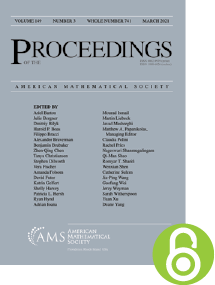The Ceva property characterizes real, strictly convex Banach spaces
HTML articles powered by AMS MathViewer
- by J. E. Valentine and S. G. Wayment PDF
- Proc. Amer. Math. Soc. 78 (1980), 559-567 Request permission
Abstract:
If a, b, c are distinct collinear points of a metric space, then \[ (a,b,c) = \left \{ {\begin {array}{*{20}{c}} {ab/bc} \hfill & {{\text {if}}\;b\;{\text {is}}\;{\text {between}}\;a\;{\text {and}}\;c,} \hfill \\ { - (ab/bc)} \hfill & {{\text {otherwise}}.} \hfill \\ \end {array} } \right .\] A metric space satisfies the Ceva Property provided for each triple of noncollinear points p, q, r, if s,t,u are points distinct from p, q, r on the metric lines $L(p,q),L(q,r)$, and $L(r,p)$, respectively, then the metric lines $L(p,t),L(q,u)$, and $L(r,s)$ have a common point if and only if $(p,s,q)(q,t,r)(r,u,p) = 1$, and $pq/ps \ne pu/pr$. In the euclidean plane, the requirement that $pq/ps \ne pu/pr$ forces the lines $L(r,s)$ and $L(q,u)$ to have a common point. Thus the case of parallel lines is avoided and the Ceva Property is meaningful in an arbitrary metric space. The main result of the paper is that a complete, convex, externally convex, metric space is a strictly convex Banach space over the reals if and only if it satisfies the Ceva Property.References
- E. Z. Andalafte and L. M. Blumenthal, Metric characterizations of Banach and Euclidean spaces, Fund. Math. 55 (1964), 23–55. MR 165338, DOI 10.4064/fm-55-1-23-55
- Leonard M. Blumenthal, Theory and applications of distance geometry, Oxford, at the Clarendon Press, 1953. MR 0054981
Additional Information
- © Copyright 1980 American Mathematical Society
- Journal: Proc. Amer. Math. Soc. 78 (1980), 559-567
- MSC: Primary 51F99; Secondary 46B20, 52A01
- DOI: https://doi.org/10.1090/S0002-9939-1980-0556633-2
- MathSciNet review: 556633


